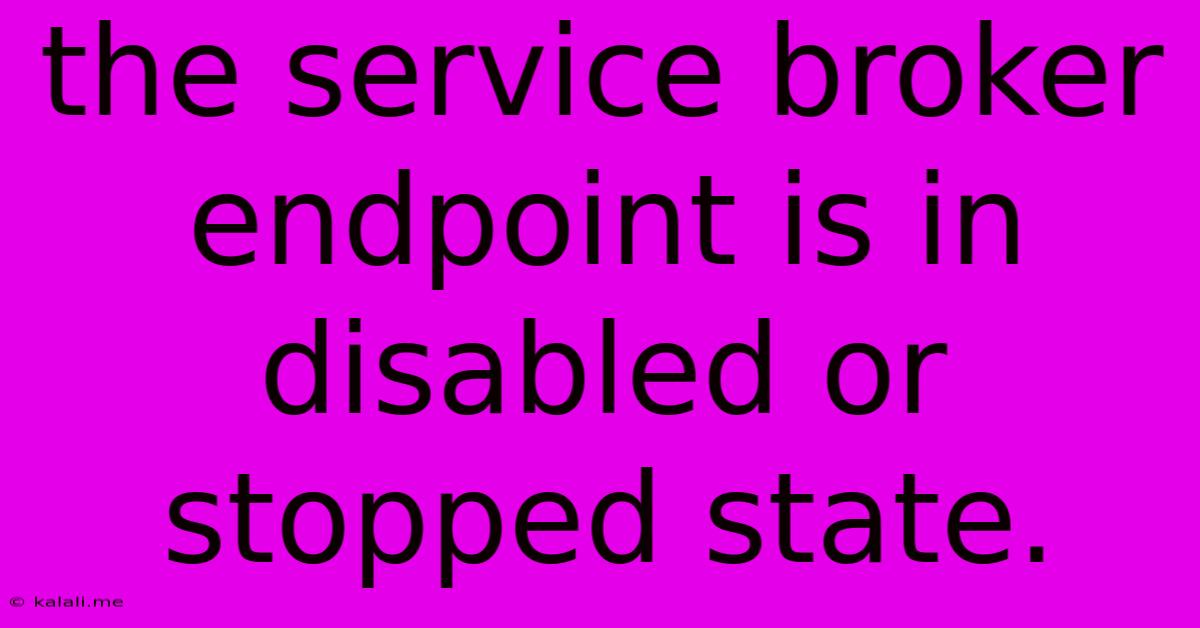The Service Broker Endpoint Is In Disabled Or Stopped State.
Kalali
May 31, 2025 · 4 min read

Table of Contents
The Service Broker Endpoint is in Disabled or Stopped State: Troubleshooting and Solutions
The error "The service broker endpoint is in disabled or stopped state" is a common issue encountered when working with Azure Service Bus, often indicating a problem with the connection or configuration of your application to the Service Bus namespace. This comprehensive guide will walk you through troubleshooting this error and implementing effective solutions. Understanding the underlying causes is crucial for preventing future occurrences.
This article will cover various troubleshooting steps, ranging from simple checks to more advanced diagnostic techniques. We will explore potential causes, such as incorrect connection strings, network issues, and service bus limitations. By following these steps, you can quickly identify and resolve the problem, ensuring smooth operation of your applications.
Understanding the Error
Before diving into solutions, let's clarify what this error message means. The Service Broker endpoint, in the context of Azure Service Bus, refers to the communication channel your application uses to interact with the Service Bus namespace. When it's in a disabled or stopped state, your application cannot send or receive messages. This prevents any further communication with your queue, topic, or subscription.
Common Causes and Troubleshooting Steps
Several factors can lead to this error. Let's explore the most frequent culprits and how to address them:
1. Incorrect or Expired Connection String:
- Problem: The most prevalent cause is an incorrect or expired connection string. Ensure you're using the correct connection string for your Service Bus namespace, including the correct policy and access rights. A common mistake is using a connection string for a different namespace or a string that's no longer valid.
- Solution: Double-check your connection string in your application configuration. Verify its validity in the Azure portal under your Service Bus namespace. Generate a new connection string if necessary, making sure the key has the appropriate permissions. Consider using managed identities where applicable to improve security.
2. Network Connectivity Issues:
- Problem: Your application may be unable to reach the Service Bus namespace due to network connectivity problems. This could involve firewall restrictions, VPN issues, or problems with DNS resolution.
- Solution: Verify your network connectivity. Check if the firewall allows outbound connections to the Service Bus namespace endpoint (usually over port 443). Test connectivity using tools like
pingandtelnetto diagnose network-related problems. If using a VPN, ensure it's properly configured and connected.
3. Service Bus Namespace Issues:
- Problem: The Service Bus namespace itself might be experiencing temporary outages or scaling issues. Though rare, this can still prevent your application from connecting.
- Solution: Check the Azure portal for any alerts or service health issues related to your Service Bus namespace. Look for any ongoing maintenance or incidents. Contact Azure support if you suspect a service-side problem.
4. Application Configuration Errors:
- Problem: Errors in your application's configuration, such as incorrect endpoint settings or missing dependencies, can prevent it from properly connecting to the Service Bus endpoint. This could involve typos in the connection string or incorrect settings in your code.
- Solution: Carefully review your application's code and configuration files. Look for any typos in the connection string or any other misconfigurations that might interfere with connection establishment. Pay attention to any error messages thrown by your application.
5. Authorization Issues:
- Problem: Insufficient privileges in your connection string or a lack of permissions assigned to the user or identity accessing the namespace can lead to connection failures.
- Solution: Double-check the access rights associated with the connection string you're using. The user or identity attempting to access the Service Bus must have the necessary permissions to send and receive messages. Verify the roles assigned in your Azure Active Directory.
Advanced Troubleshooting Techniques
If the basic troubleshooting steps don't resolve the issue, consider these more advanced techniques:
- Azure Monitor: Analyze logs and metrics in Azure Monitor for insights into potential problems. This can reveal errors or performance bottlenecks that are affecting your application's ability to connect to Service Bus.
- Network Tracing: Use network tracing tools to capture network traffic and identify any network-related issues that might be hindering communication with the Service Bus endpoint.
- Service Bus Explorer: This tool provides a visual interface to interact with your Service Bus namespace. You can use it to verify the status of your queues, topics, and subscriptions.
By systematically working through these troubleshooting steps, you should be able to resolve the "The service broker endpoint is in disabled or stopped state" error and restore the functionality of your Azure Service Bus application. Remember to always prioritize secure coding practices and regularly review your connection string configurations.
Latest Posts
Latest Posts
-
4 Stroke Vs 2 Stroke Engine
Jun 02, 2025
-
Jacob I Have Loved But Esau I Have Hated
Jun 02, 2025
-
How Do You Say Yours In Spanish
Jun 02, 2025
-
Fresh Basil To Dry Basil Equivalent
Jun 02, 2025
-
How To Say Or In Japanese
Jun 02, 2025
Related Post
Thank you for visiting our website which covers about The Service Broker Endpoint Is In Disabled Or Stopped State. . We hope the information provided has been useful to you. Feel free to contact us if you have any questions or need further assistance. See you next time and don't miss to bookmark.